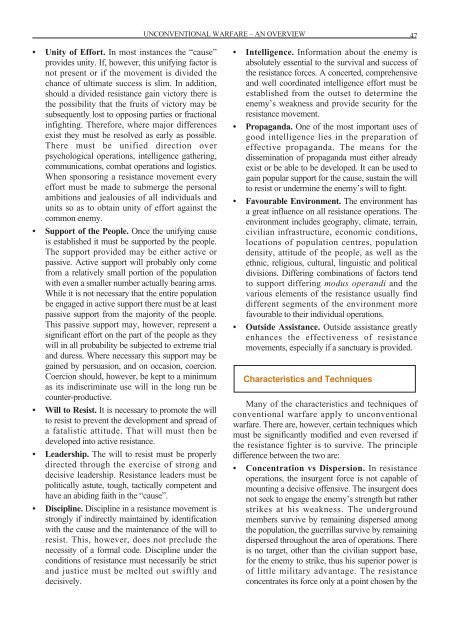ISSUE 136 : May/Jun - 1999 - Australian Defence Force Journal
ISSUE 136 : May/Jun - 1999 - Australian Defence Force Journal
ISSUE 136 : May/Jun - 1999 - Australian Defence Force Journal
- No tags were found...
You also want an ePaper? Increase the reach of your titles
YUMPU automatically turns print PDFs into web optimized ePapers that Google loves.
UNCONVENTIONAL WARFARE – AN OVERVIEW 47• Unity of Effort. In most instances the “cause”provides unity. If, however, this unifying factor isnot present or if the movement is divided thechance of ultimate success is slim. In addition,should a divided resistance gain victory there isthe possibility that the fruits of victory may besubsequently lost to opposing parties or fractionalinfighting. Therefore, where major differencesexist they must be resolved as early as possible.There must be unified direction overpsychological operations, intelligence gathering,communications, combat operations and logistics.When sponsoring a resistance movement everyeffort must be made to submerge the personalambitions and jealousies of all individuals andunits so as to obtain unity of effort against thecommon enemy.• Support of the People. Once the unifying causeis established it must be supported by the people.The support provided may be either active orpassive. Active support will probably only comefrom a relatively small portion of the populationwith even a smaller number actually bearing arms.While it is not necessary that the entire populationbe engaged in active support there must be at leastpassive support from the majority of the people.This passive support may, however, represent asignificant effort on the part of the people as theywill in all probability be subjected to extreme trialand duress. Where necessary this support may begained by persuasion, and on occasion, coercion.Coercion should, however, be kept to a minimumas its indiscriminate use will in the long run becounter-productive.• Will to Resist. It is necessary to promote the willto resist to prevent the development and spread ofa fatalistic attitude. That will must then bedeveloped into active resistance.• Leadership. The will to resist must be properlydirected through the exercise of strong anddecisive leadership. Resistance leaders must bepolitically astute, tough, tactically competent andhave an abiding faith in the “cause”.• Discipline. Discipline in a resistance movement isstrongly if indirectly maintained by identificationwith the cause and the maintenance of the will toresist. This, however, does not preclude thenecessity of a formal code. Discipline under theconditions of resistance must necessarily be strictand justice must be melted out swiftly anddecisively.• Intelligence. Information about the enemy isabsolutely essential to the survival and success ofthe resistance forces. A concerted, comprehensiveand well coordinated intelligence effort must beestablished from the outset to determine theenemy’s weakness and provide security for theresistance movement.• Propaganda. One of the most important uses ofgood intelligence lies in the preparation ofeffective propaganda. The means for thedissemination of propaganda must either alreadyexist or be able to be developed. It can be used togain popular support for the cause, sustain the willto resist or undermine the enemy’s will to fight.• Favourable Environment. The environment hasa great influence on all resistance operations. Theenvironment includes geography, climate, terrain,civilian infrastructure, economic conditions,locations of population centres, populationdensity, attitude of the people, as well as theethnic, religious, cultural, linguistic and politicaldivisions. Differing combinations of factors tendto support differing modus operandi and thevarious elements of the resistance usually finddifferent segments of the environment morefavourable to their individual operations.• Outside Assistance. Outside assistance greatlyenhances the effectiveness of resistancemovements, especially if a sanctuary is provided.Characteristics and TechniquesMany of the characteristics and techniques ofconventional warfare apply to unconventionalwarfare. There are, however, certain techniques whichmust be significantly modified and even reversed ifthe resistance fighter is to survive. The principledifference between the two are:• Concentration vs Dispersion. In resistanceoperations, the insurgent force is not capable ofmounting a decisive offensive. The insurgent doesnot seek to engage the enemy’s strength but ratherstrikes at his weakness. The undergroundmembers survive by remaining dispersed amongthe population, the guerrillas survive by remainingdispersed throughout the area of operations. Thereis no target, other than the civilian support base,for the enemy to strike, thus his superior power isof little military advantage. The resistanceconcentrates its force only at a point chosen by the

















